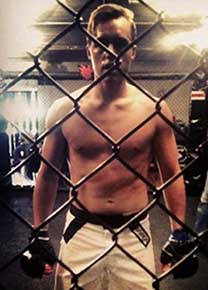
Are you a good Karate fighter?
Many people think kumite is difficult…
I agree.
Even though I’ve trained with world class coaches, athletes and fighters, I have tons to improve.
Luckily, I know the secret to becoming a better fighter.
Be like a ninja!
How?
I’m glad you asked…
Here are 3 ninja tactics you need to know:
#1. “Go Where The Puck Will Be”
When legendary ice hockey player Wayne Gretzky was asked about his secret to success, he replied:
“I don’t go where the puck is. I go where the puck will be.”
The same holds true for kumite.
Instead of aiming where your opponent is, aim where your opponent will be.
That’s why the first thing you should do in a fight is OBSERVE.
Don’t just mindlessly start fighting. Make an effort to observe the rhythm, movements and habits of your opponent.
Once you’ve identified a pattern, attack!
Not where your opponent is – but where your opponent will be.
Naturally, this also applies the other way…
Don’t allow your opponent to sense your intentions.
Have an aura of unpredictability.
Like a ninja.
#2. Relative, Not Absolute Speed

A key to being a ninja is speed.
You can’t defend against something you can’t see.
But…
There’s something more important than speed.
Changing speed.
In other words, focus on relative speed – not absolute speed.
If you have a constant speed in kumite, your opponent learns to read you (even if you’re quick). A steady pace makes you predictable and easy to hit.
The key lies in shifting between fast & slow.
Learn to play with the rhythm, tempo and timing of your techniques.
You don’t always need to be faster than your opponent. But you need to vary your speed better.
Acceleration and deacceleration.
Yin and yang.
3. Position > Demolition
Finally, let’s talk defense.
Your opponent can attack you in a thousand different ways.
According to Hick’s Law, the more defensive moves (blocks, counter techniques etc.) you have in your arsenal, the less chance you have of actually being able to use any of them. That’s how the brain works.
So, don’t focus on memorizing specific ways to defend against attacks.
Instead, focus on defending yourself against positions.
Positional management.
By position yourself lika a ninja (through adjusting your distance & angle), you will have an advantage in both defense and offense. This comes before all else.
Stop practicing tons of defensive techniques. Start practicing how to position yourself better.
Like a game of chess.
The person who controls the positions controls the fight. That’s why the greatest fighters obsess over footwork.
“Float like a butterfly, sting like a bee…”
——————
That’s it!
3 ninja tactics to become a better Karate fighter.
Do you know other kumite strategies?
Leave a comment & share! 🙂



39 Comments